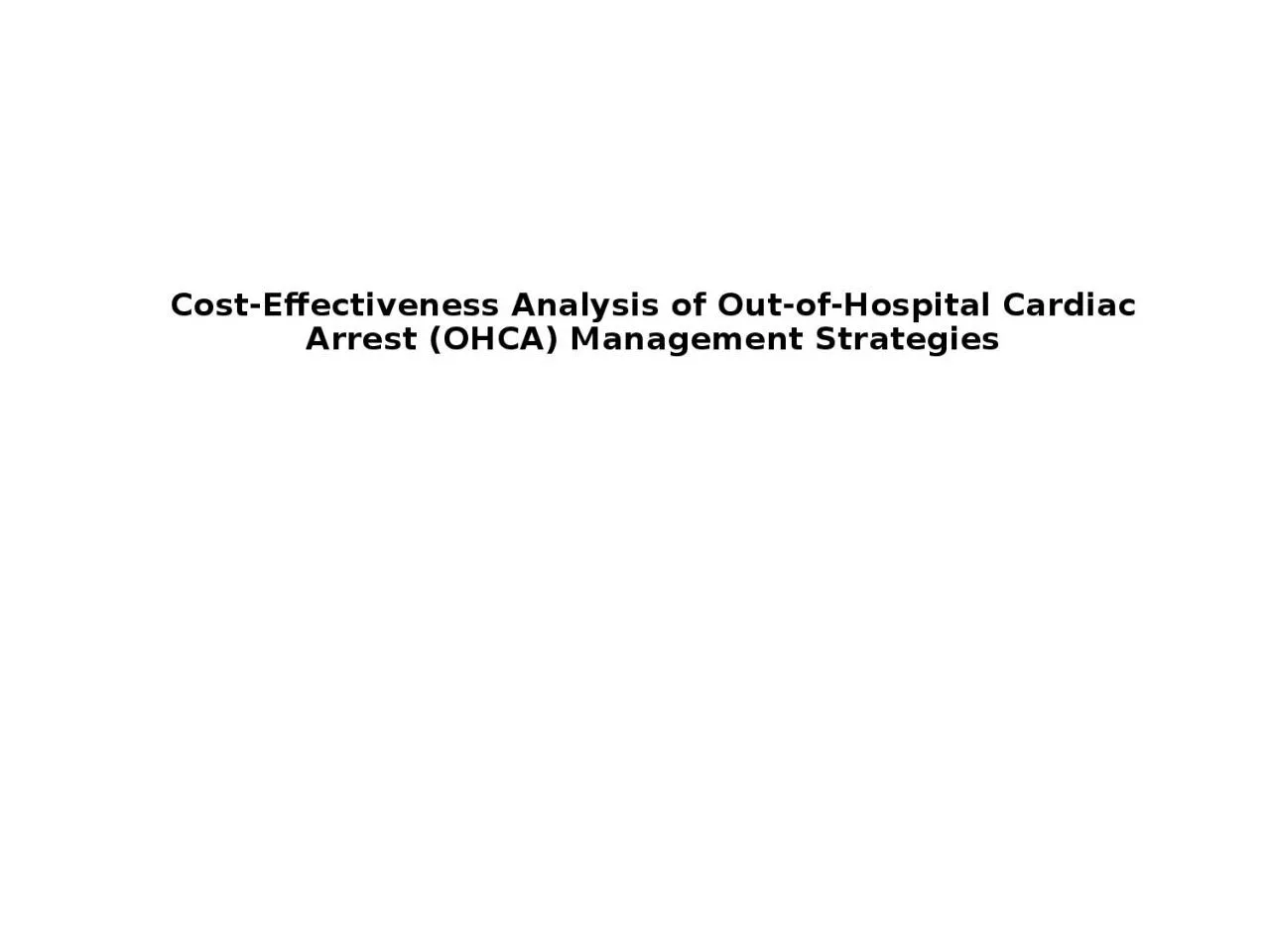

Introduction Outofhospital cardiac arrest OHCA is the sudden cessation of the heart in an out of hospital setting In the United States the incidence of OHCA is estimated at 110 individuals per 100000 The overall survival rate is 108 The American Heart Association AHA guidelines recom ID: 1036019
Download Presentation The PPT/PDF document " Cost-Effectiveness Analysis of Out-of..." is the property of its rightful owner. Permission is granted to download and print the materials on this web site for personal, non-commercial use only, and to display it on your personal computer provided you do not modify the materials and that you retain all copyright notices contained in the materials. By downloading content from our website, you accept the terms of this agreement.
1. Cost-Effectiveness Analysis of Out-of-Hospital Cardiac Arrest (OHCA) Management Strategies
2. IntroductionOut-of-hospital cardiac arrest (OHCA) is the sudden cessation of the heart in an out of hospital setting. In the United States, the incidence of OHCA is estimated at 110 individuals per 100,000 . The overall survival rate is 10.8%. The American Heart Association (AHA) guidelines recommends angiography for patients who have ST elevation in electrocardiogram followed by proper treatments. In patients without ST elevation, other general test and observations would be conducted before further interventions. Some evidence suggests that angiography and immediate percutaneous intervention for OHCA patients could result in better healthcare outcomes regardless of the presence of ST elevation in electrocardiogram. The goal of this study is to investigate whether immediate angiography and PCI are cost-effective compared to the standard of care. It is important to state the time duration.
3. MethodsWe built a decision tree model in TreeAge Pro to compare the cost-effectiveness of immediate angiography followed by proper interventions to standard care. The model calculates the costs and benefits of each strategy over a one-year time-horizon. We reviewed the literatures to obtain the model parameters, including the outcome probabilities, intervention costs, quality of life weights and life expectancy estimates. We calculated the incremental cost-effectiveness ratio of immediate angiography strategy compared to standard of care. In addition, we calculated the robustness of our outcomes using one-way sensitivity analysis, and probabilistic sensitivity analysis (PSA) were varied all the parameters jointly.
4. Model
5. Base case estimates and ranges Base Case EstimateRangeReference or SourceNotesProbability values All are following Beta distributionSensitivity of EKG0.880.74-0.96(3)α= 36.3; β=4.95Larger than 70% stenosis0.660.561-0.759*(15)α =58.58; β =30.18Larger than 70% stenosis conditional on true positive EKG result0.960.816-1.000*(2)α =6.15; β =0.256Larger than 70% stenosis conditional on false negative EKG result0.580.493-0.667*(2)α =74.09; β =53.65PCI succeed0.740.629-0.851*(2)α =45.48; β =15.98 Cost ($) All are following Log normal distributionProcedures of PCI35,99118,842-53,140(8)µ=10.46; σ=0.235Procedures of CABG39,58125,828-53,334(8)µ =10.57; σ =0.173Procedures of medical treatment in immediate action37,478**31,856-43,100*(9)µ =10.53; σ =0.075Procedures of medical treatment in delayed action38,154**32,431-43,877*(10)µ =10.55; σ =0.075 Quality adjusted life-years (QALY) All are following Beta distributionPCI procedures in immediate action0.820.63-1.00(3)α=12.59; β =2.76CABG procedures in immediate action0.800.64-0.96(3)α =19.2; β =4.8Medical treatments0.9110.77-1.00*(7)α =13.95; β =1.36PCI procedures in delayed action0.7000.595-0.805*(6)α =52.63; β =22.56CABG procedures in delayed action0.6430.547-0.740*(6)α =63.42; β =35.21 The base case value means the best estimate for each variables. Unless otherwise noted, ranges are defined by 95% confidence intervals.* The range are estimated from 85% to 115%** The values are from the calculation of inflation¶ estimate from the study
6. AnalysisFor both treatment strategies, our model calculated quality adjusted life years and costs in 1-year time horizon. We compared the performance of the two treatment strategies through the incremental cost-effectiveness ratio (ICER), defined as marginal cost divided by the marginal effectiveness. We conducted one-way sensitivity analyses for every variable in our model to assess the influences of them within a clinically plausible range on cost-effectiveness. And we plotted the Tornado diagrams for probability, cost and effectiveness. Additionally, we conducted Probabilistic sensitivity analysis (PSA) through Monte Carlo simulation. We thought probabilities and quality adjusted life-years are following Beta distribution and the cost of interventions are following Log-normal distribution.
7. ResultsImmediate angiography was more expensive than the standard care ($122) per patient treated, but more effective [0.03 quality-adjusted life-years (QALYs)], resulting in an ICER of $3600/QALY compared to the standard care. These findings were robust to all one-way sensitivity analyses. In addition, the PSA showed that there is more than 80% probability that immediate angiography is more cost effective than the standard care conditional on $100,000/QALY willingness to pay threshold.StrategyCostIncr CostEffIncr effIncrC/E (ICER)NMBC/EStandard care36951.73 0.81 3748.9345394.51Immediate Angiography37073.55121.830.850.033637.165301.8543744.19Incremental Cost Effectiveness Ratio (ICER)
8. One-way sensitivity analysis (Tornado Diagram)
9. ComponentQuadrantIncr EffIncr CostIncr CEFrequencyProportionC1IVIE>0IC<0Superior40970.4097C2IIE>0IC>0ICER<100,00043660.4366C3IIIIE<0IC<0ICER>100,0001880.0188C4IIE>0IC>0ICER>100,0007060.0706C5IIIIE<0IC<0ICER<100,0002050.0205C6IIIE<0IC>0inferior4380.0438C2C4C6C3C5C1Probabilistic Sensitivity Analysis
10. The acceptability curve shows the probability of being cost-effective under different threshold of willingness to pay.
11. ConclusionOur results suggest that immediate angiography is more cost effective than the standard care for OHCA patients from a societal perspective because the ICER is well below the upper limit of the threshold that is generally considered to be cost-effective by many health-care agencies.
12. FutureMicro-Cost AnalysisUpdate latest dataModifying treatment guidelinesReallocating healthcare resources